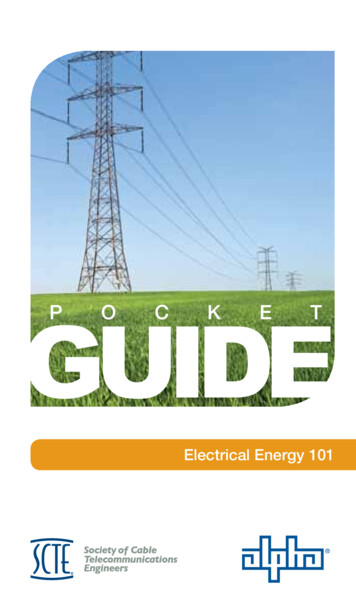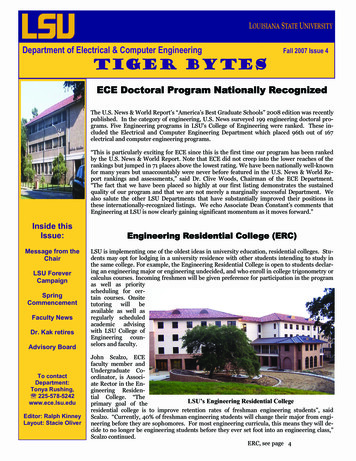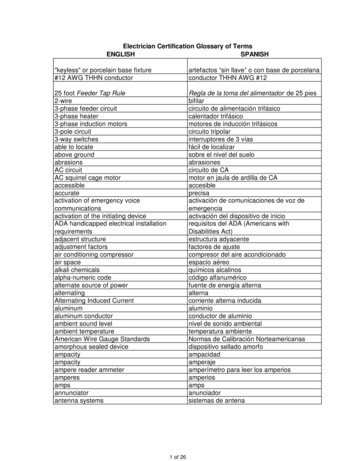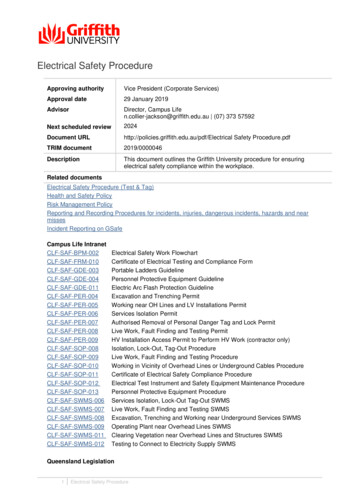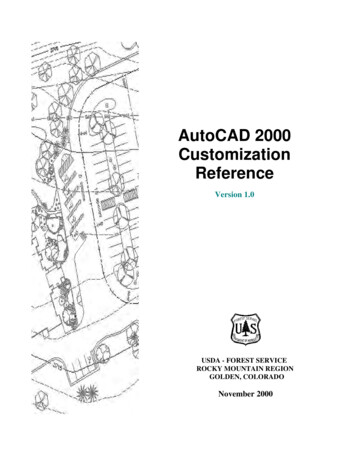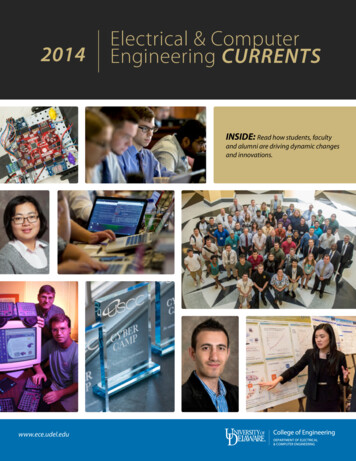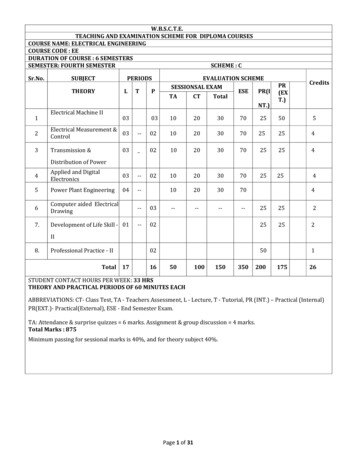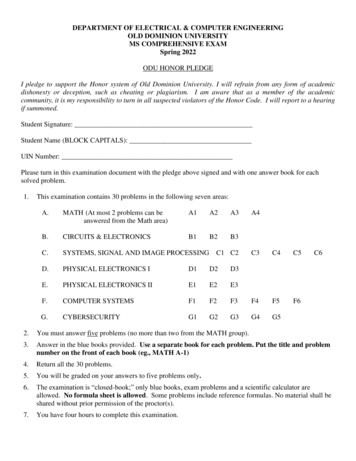
Transcription
DEPARTMENT OF ELECTRICAL & COMPUTER ENGINEERINGOLD DOMINION UNIVERSITYMS COMPREHENSIVE EXAMSpring 2022ODU HONOR PLEDGEI pledge to support the Honor system of Old Dominion University. I will refrain from any form of academicdishonesty or deception, such as cheating or plagiarism. I am aware that as a member of the academiccommunity, it is my responsibility to turn in all suspected violators of the Honor Code. I will report to a hearingif summoned.Student Signature:Student Name (BLOCK CAPITALS):UIN Number:Please turn in this examination document with the pledge above signed and with one answer book for eachsolved problem.1.This examination contains 30 problems in the following seven areas:A.MATH (At most 2 problems can beanswered from the Math area)A1A2A3B.CIRCUITS & ELECTRONICSB1B2B3C.SYSTEMS, SIGNAL AND IMAGE PROCESSINGD.PHYSICAL ELECTRONICS ID1D2D3E.PHYSICAL ELECTRONICS IIE1E2E3F.COMPUTER SYSTEMSF1F2G.CYBERSECURITYG1G2C1 C2A4C3C4C5F3F4F5F6G3G4G5C62.You must answer five problems (no more than two from the MATH group).3.Answer in the blue books provided. Use a separate book for each problem. Put the title and problemnumber on the front of each book (eg., MATH A-1)4.Return all the 30 problems.5.You will be graded on your answers to five problems only.6.The examination is “closed-book;” only blue books, exam problems and a scientific calculator areallowed. No formula sheet is allowed. Some problems include reference formulas. No material shall beshared without prior permission of the proctor(s).7.You have four hours to complete this examination.
DEPARTMENT OF ELECTRICAL & COMPUTER ENGINEERINGOLD DOMINION UNIVERSITYPH.D. DIAGNOSTIC EXAMSpring 2022ODU HONOR PLEDGEI pledge to support the Honor system of Old Dominion University. I will refrain from any form of academicdishonesty or deception, such as cheating or plagiarism. I am aware that as a member of the academiccommunity, it is my responsibility to turn in all suspected violators of the Honor Code. I will report to a hearingif summoned.Student Signature:Student Name (BLOCK CAPITALS):UIN Number:Please turn in this examination document with the pledge above signed and with one answer book for eachsolved problem.1. This examination contains 30 problems in the following seven areas:A.MATH (At most 3 problems can beanswered from the Math area)A1A2A3B.CIRCUITS & ELECTRONICSB1B2B3C.SYSTEMS, SIGNAL AND IMAGE PROCESSINGD.PHYSICAL ELECTRONICS ID1D2D3E.PHYSICAL ELECTRONICS IIE1E2E3F.COMPUTER SYSTEMSF1F2G.CYBERSECURITYG1G2C1 C2A4C3C4C5F3F4F5F6G3G4G5C62. You must answer eight problems (no more than three from the MATH group).3. Answer in the blue books provided. Use a separate book for each problem. Put the title and problemnumber on the front of each book (eg., MATH A-1)4. Return all the 30 problems.5. You will be graded on your answers to eight problems only.6. The examination is “closed-book;” only blue books, exam problems and a scientific calculator areallowed. No formula sheet is allowed. Some problems include reference formulas. No material shall beshared without prior permission of the proctor(s).7.You have four hours to complete this examination.
PROBLEM A1 – MATHSolve the nonhomogeneous equationy’’-4y’ 3y 10e-2x
PROBLEM A2 – MATHNote: dl is the vector path length along the contour.
PROBLEM A3 – MATHLinear AlgebraConsider the matrix 1 1 2 A 0 0 1 1 0 0 1. Determine the LU factorization of matrix A , that is find matrices P , L , and Usuch that PA LU , where P is a permutation matrix, L is a lower triangularmatrix with all diagonal elements equal to 1, and U is an upper triangular matrix.2. Determine the QR factorization of matrix A by applying the Gram-Schmidtorthogonalization procedure to determine an orthogonal matrix Q and an uppertriangular matrix R such that A QR .3. Discuss how the LU and QR factorizations are used in the context of solvingsystems of linear equations.
PROBLEM A4 – MATHProbability
PROBLEM B1 – CIRCUITS AND ELECTRONICS
PROBLEM B2 – CIRCUITS AND ELECTRONICS
PROBLEM B3 – CIRCUITS AND ELECTRONICSAssume that vi is a 1 kHz, 10 V peak rectangle wave as shown in below figure and diodes areideal and have no voltage drop.20VVin10V1mAV0-10V5kW-2V(a)VinSketch the waveform resulting at vo and show your work10V-10V(b)Sketch the transfer characteristic vo versus vin and show your works
PROBLEM C1 – SYSTEMS, SIGNALS AND IMAGE PROCESSINGDigital Image Processing(a)(b)The two purely black and white images shown above are each 40 x 40 pixels. Each image contains anequal number of black and white pixels, which are represented using 8-bit grayscale intensity levels.The black lines around the boarder signify the image edges and are not pixels. Answer the followingquestions. Clary label all axes.a. Sketch the histogram of each image, a and b.b. Suppose each image is smoothed using a 3x3 uniform filter having coefficients that sum to 1.Disregarding the pixels that are affected by the image boundaries, determine all unique pixelintensity values that will be present in each smoothed image.c. Roughly sketch the two resulting histograms from part b.d. Roughly sketch the 2D Discrete Fourier Transform (DFT) of each original image (Prior to smoothing)
PROBLEM C2 – SYSTEMS, SIGNALS AND IMAGE PROCESSING(a). (2 points) Given x[n] u[n] – u[n-1000] and h[n] u[n] – u[n-50]. If y[n] is the linearconvolution of x[n] and h[n] as y[n] x[n] * h[n], what is the maximum value of y[n]?(b). (2 points) What is the fundamental period of 𝑥[𝑛] 𝑐𝑜𝑠( 19 𝜋𝑛)?(c). (3 points) Let h[n] denote the impulse response of a LTID systemh[n] u[n]what is the zero-state response for the input of h[n] (1/3)nu[n-2]?(d). (3 points) Two finite length signals, x1[n] and x2[n] are given as:x1[n] 2u[n] – 2u[n-6]x2[n] u[n] – u[n-4]Let y[n] be the linear convolution of x1[n] and x2[n] Determine y[n].
PROBLEM C3 – SYSTEMS, SIGNALS AND IMAGE PROCESSINGAn analog signal, x(t), has a bandwidth of 40k Hz. In this problem, you will work as an engineer todesign a simple discrete-time signal processing system to process the signal.a) (2 points) In the first step, you will sample this analog signal. What is the Nyquist rate for x(t)?b) (4 points) Assume that you sampled the analog signal, x(t), using a sampling frequency of 90k Hzand obtained a discrete-time signal x[n], what is the highest frequency in x[n]?c) (4 points) If you want to design a discrete-time low-pass filter h[n] to filter out all frequencycomponents beyond 5k Hz in x(t), what is the cut-off frequency of h[n]?
PROBLEM C4 – SYSTEMS, SIGNALS AND IMAGE PROCESSINGControl SystemsConsider the block diagram of a closed-loop position control system in Figure C2.1where the transfer function of the plant is5.Gp ( s ) s ( s 5)R(s)U(s) Gc(s) Gp(s)C(s)-Figure C2.1. Block diagram of a closed-loop system.a) If a proportional controller is used, that is, Gc ( s ) K , find the following twoU (s)C (s). If the closed-loopand Tru ( s ) R (s)R (s)system is asymptotically stable, find the initial and final values of the unit stepresponses corresponding to c(t) and u(t).b) Analytically find the range of values for the gain K that make the closed-loopsystem asymptotically stable.c) Find the range of gains K that make the steady-state error to the inputr ( t ) 5, t 0 be less than 1%.d) Design a proportional controller that results in a stable closed-loop system withlittle if any overshoot to a step response. What is the approximate gain marginof this design? What is the significance of the gain margin?transfer functions: Trc ( s ) Laplace’s TheoremsLet F(s) be the Laplace transform of f(t) .Initial Value Theorem Now, if F(s) be a strictly proper rational transferfunction (degree denominator degree numerator),then( )f 0 lim sF ( s ) .s Final Value Theorem If all the poles of sF(s) have negative real parts, thenlim f (t ) lim sF ( s ) .t 119s 0PE Review - Copyright by Dr. González
PROBLEM C5 – SYSTEMS, SIGNALS AND IMAGE PROCESSINGCommunications Problem:Consider a sinusoidal carrier c(t ) Ac cos( 2 f c t ) and the information-bearing signalm(t ) Am cos( 2 f m t ) where f c f m .1. Describe how frequency modulation (FM) of the carrier c(t ) with m(t ) isaccomplished and write the mathematical expression of the resulting FM signal u(t ) .Argue whether FM is a linear modulation scheme or not.Note: you must provide mathematical proof to get credit.2. Write the expression of the maximum frequency deviation f max for the FM signaland define the modulation index f for the FM scheme.3. Write the expressions of the pre-envelope signal u (t ) and of the complex envelopeu (t ) corresponding to the FM signal u(t ) , and determine the in-phase and quadraturecomponents u I (t ) and u Q (t ) of the FM signal u(t ) .4. Argue that u (t ) is periodic and use its Fourier series representation to evaluate thespectrum of the FM signal u(t ) .USEFUL MATHEMATICAL FORMULASTrigonometric identities:sin( x y) sin x cos y sin y cos xcos( x y) cos x cos y sin x sin ycos(x - y) cos(x y)cos( x) cos(y) 2cos(x - y) - cos(x y)sin(x) sin(y) 2sin(x - y) sin(x y)sin( x) cos(y) 2Euler’s formulae jx cos( x) j sin( x)Hilbert transform pairsH cos 2 f c t sin 2 f c tH sin 2 f c t cos 2 f c t j 2 f tFourier transform pair: F e 0 ( f f 0 )
PROBLEM C6 – SYSTEMS, SIGNALS AND IMAGE PROCESSINGCommunications Networks1. (5 pts) We have a character frame from the higher layer: A B FLAG C. Assume the bytestuffing framing method is used at the data link layer, what will be the actual frame to be transmitted?Note the special characters are FLAG and ESC.2. (5pts) The data link layer retransmits a frame if it is not acknowledged by the receiver. Ifthe probability of a frame being damaged is p, and the probability of an ACK being damagedis q. Suppose the user data contains n frames. What is the mean number of transmissions needed to letthe receiver successfully receive all frames?
PROBLEM D1 – PHYSICAL ELECTRONICS IA 60-MHz plane wave traveling in the negative x-direction in dry soil with relative permittivityεr 4 has an electric field polarized along the z-direction [i.e., 𝐸 𝑧𝐸(𝑡, 𝑥)]. Dry soil isassumed to be lossless. Given that the magnetic field has a peak value of 10 (mA/m) and that itsvalue was measured to be 7 (mA/m) at t 0 and x 0.75 m, develop complete expressions forthe wave’s electric 𝐸 (𝑥, 𝑡) and magnetic fields 𝐻 (𝑥, 𝑡) by calculate the angular frequency,wavenumber, and initial phase. Must indicate the direction of the fields as well as the units.
PROBLEM D2 – PHYSICAL ELECTRONICS IElectromagneticsA small sphere of mass M in a gravity field g carrying a charge Q is connected by a masslessstring to a sheet of surface charge of the same polarity with density 0. What is the angle between the sheet and charge?
PROBLEM D3 – PHYSICAL ELECTRONICS IFiber Optics CommunicationsDerive the expressions of the numerical aperture, NA, and the acceptance angle,ϴa, of an optical fiber with a core refractive index n1 and a cladding refractiveindex n2. Show all details of your derivation.
PROBLEM E1 - PHYSICAL ELECTRONICS IIConsider a long n-channel MOSFET characterized by the following technicalparameters:N polySi gate (with work function ΦM χS 4.04 eV);gate oxide thickness dox 15 nm,uniform doping NA 10 17 cm-3 ; length L 1.0 μm, width Z 10.0 μm,at a bias given by VG 2.5 V, and VDS 1.0V, plus back-bias VBS 0 V.Use μe 500 cm2/ V-s.a) Calculate the oxide capacitance Cox and the factor K (εs q NA)1/2/Coxb) Calculate the surface potential Ψsc) Calculate the flatband voltage VFBd) Calculate the threshold voltage VTe) Calculate the sheet charge density Qi (x 0) at the source end of the channelat the indicated bias.f) Calculate the sheet charge density Qi (x L) at the drain end of the channel atthe indicated bias. Determine if this MOSFET is actually biased in the linearregime or the saturation regime.g) Calculate the drain current IDIf the same MOSFET is now biased with VG 2.5 V and VDS 4 V,the transistor is now biased in the saturation regime.a) Calculate the saturation drain current IDsat
PROBLEM E2 – PHYSICAL ELECTRONICS IIPhysical electronics1. Draw a (011) plane and a (111) plane for crystalline silicon2. Using an energy-momentum diagram, explain the difference between a direct bandgapsemiconductor and indirect bandgap semiconductor. Give two examples ofsemiconductor for each type of bandgap, and explain what is the most suited deviceapplication for each type of bandgap.3. An ideal silicon junction has N A 2 1019 cm-3 and N D 4 1015 cm-3 . Calculate thedepletion layer width, the maximum field and the junction capacitance at zero volt andat reverse bias of 3V (T 300K).A list of equations and data is provided to you below. Please note that not all equationsand data should be used.Silicon (300 K): N C 2.86 1019 cm-3 ; N V 2.66 1019 cm-3 ; ni 9.65 109 cm-3mp 1 m0 ; mn 0.19 m0 ; m0 0.91 10-30 kg; k 1.38 10-23 J/K ; q 1.6 10-19 C
PROBLEM E3 – PHYSICAL ELECTRONICS II(5 points) (a) For a Maxwellian electron speed distribution:𝑓(𝑣) 4𝜋𝜐2𝑚2𝜋𝑘𝑇32𝑚𝜐2𝑒 2𝑘𝑇Calculate the most probable speed.(5 points) (b) Calculate the mean speed of the following distribution function of speed?𝑓(𝑣) 3𝑛𝑣 2for 0 𝑣 1 and 𝑓(𝑣) 0 otherwise, n is the particle density.
PROBLEM F1 – COMPUTER SYSTEMSMicroprocessorsContinued on next page
PROBLEM F2 – COMPUTER SYSTEMSDigital Systems
PROBLEM F3 – COMPUTER SYSTEMSComputer Architecture1. Given the following MIPS instructions, if we only implement the following hazard detectionunit without the forwarding control capacity, (1) please identify what problems it will occurwith explanation and (2) How do we fix the problem with explanation.Here is the only hazard detection unit we implement:if (ID/EX.MemRead and((ID/EX.RegisterRt IF/ID.RegisterRs) or (ID/EX.RegisterRt IF/ID.RegisterRt)))stall the pipelinelw 2, 20( 1)and 4, 2, 5or 8, 2, 62. For this question, we assume that individual stages/steps of the data-path have the followinglatencies:IFIDEXEMEM250 ps350 ps150 ps300 psWB200psWhat is the clock cycle time in this pipelined processor? What is the total latency of a MIPSaddition instruction (i.e., add) in this pipelined processor (Supposedly, there is no data,structural, or control hazard for this case)? Need to explain your answers.
PROBLEM F4 – COMPUTER SYSTEMSComputer Algorithms
PROBLEM F5 – COMPUTER SYSTEMSData Structures1. What are the preorder, inorder, and postorder traversals of the following binary tree:2. What is the order (Time Big-O Complexity) of each of following tasks in the worst case(need to explain how you get your answer to get a full credit)?2.1 Displaying all n integers in a sorted linked list.2.2 Displaying the last integer in a linked list.2.3 Adding an item to a stack of n items.
PROBLEM F6 – COMPUTER SYSTEMSLogic DesignConsider the following Boolean expression where d is don’t careF(A,B,C,D) m (0,1,3,7,8) d(5,10,13,14)(a) (4 pts) Using K-map give the minimal Sum-of-Product (SOP) form.(b) (3 pts) Draw the minimized SOP of F in part a using “NAND” and “NOT” (INV) gates.(c) (3 pts) Give the longest path delay and the shortest path delay of the circuit in part b using thegates information in the table
PROBLEM G1 – CYBERSECURITYConsider the 3-bit block cipher given in Table 1 below. Suppose the plaintext is 100100100.a) Initially assume that CBC (Cipher Block Chaining) is not used. What is the resultingciphertext?b) Suppose James sniffs the ciphertext. Assuming he knows that a 3-bit block cipherwithout CBC is being employed (but doesn’t know the specific cipher), what can shesurmise?c) Now suppose that CBC is used with Initialization Vector, IV 111. What is the 11100100011101010110000111001Table 1: A specific 3-bit block cipher
PROBLEM G2 – CYBERSECURITYSuppose your RSA modulus is n 35 5 x 7 and your encryption exponent is e 3. (a) Show how toencrypt a message “abc” and (b) find the decryption modulus d and show how to decrypt theciphertext.
PROBLEM G3 – CYBERSECURITYDiscuss three service models in cloud computing and the security risks in each service model.
PROBLEM G4 – CYBERSECURITYProblem 1 - (Format String Vulnerability)What if we want to write a small number such as 0 to a target address using a format-stringvulnerability, but due to the %x’s that we have to place in the format string, the number of charactersprinted out by printf() is already nonzero before the pointer reaches the target address. Is it stillpossible to write 0 to the target address?Problem 2 – (Buffer Overflow) 5ptsSeveral students had issue with the buffer overflow attack. Their badfile was constructed properly whereshell code is at the end of badfile, but when they try different return addresses, they get the followingobservations. Can you explain why some addresses work and some do not?
PROBLEM G5 – CYBERSECURITYSecurity and Privacy of Embedded SystemsA. Define side-channel attacks in embedded systems and identify three possible side-channelattacks, explain. (5 pts)B. Medical devices are increasingly software-controlled, personalized, and networked. Anexample of such a device is a blood glucose meter, used by doctors and patients to monitora patient’s blood glucose level. Consider a hypothetical glucose meter that can take areading of a patient’s glucose level, show it on the device’s display, and also transmit itover the network to the patient’s hospital. The code is a highly-abstracted version of thesoftware that might perform these tasksint patient id;// initialized to the patient’s unique identifiervoid take reading () {float reading read from sensor();display(reading);send (network socket, hospital server, reading, patient id);return;}The function take reading records a single blood glucose reading and stores it in a floatingpoint variable reading. It then writes this value, suitably formatted, to the device’s display.Finally, it transmits the value along with the patient’s ID without any encryption over thenetwork to the hospital server for analysis by the patient’s doctor.a. Does this program preserve privacy of the patient’s information? (2 pts)b. The flow of information from reading to network socket, which one is visible to theattacker?(3 pts)
OLD DOMINION UNIVERSITY MS COMPREHENSIVE EXAM Spring 2022 ODU HONOR PLEDGE I pledge to support the Honor system of Old Dominion University. I will refrain from any form of academic . G. CYBERSECURITY G1 G2 G3 G4 G5 2. You must answer eight problems (no more than three from the MATH group). 3. Answer in the blue books provided.

